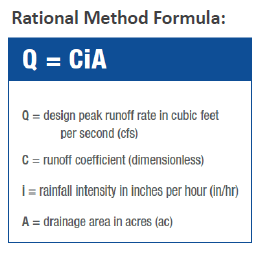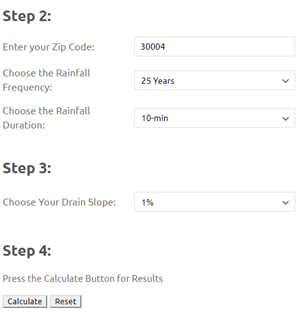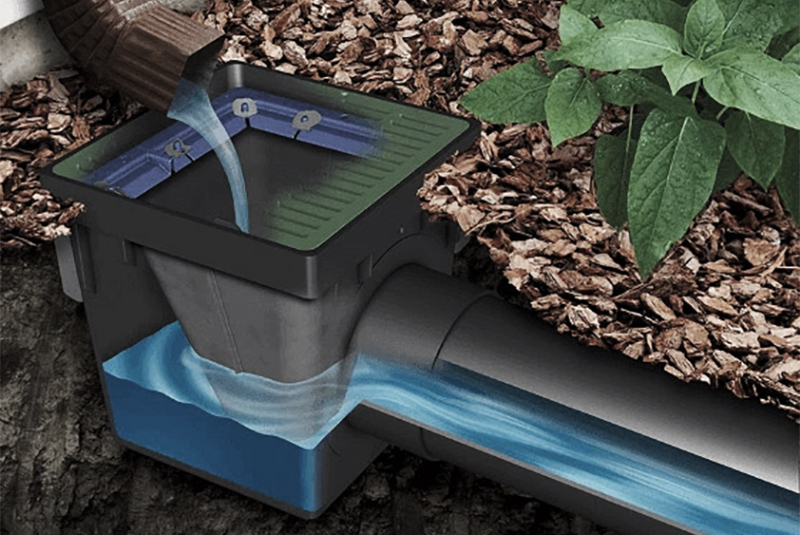When considering the details of installing a drainage project on a property we often see a common mistake play itself out over and over; the contractor guesses on the particulars. The size of the pipe, capture device and even the storage of storm water often comes down to habit and a “one size fits all” approach. Eric Cummings, Central’s Drainage Director, is an expert in the field of drainage and is here to help you problem solve the best plans for your drainage projects.
From Eric
When looking at a solution, it is crucial to keep in mind that a formula can be used to calculate a properly sized system. Storm water professionals often use the Rational Method for calculating storm water runoff peak flows for areas less than 200 acres. This formula can help us calculate peak run off rate for capture and conveyance of water as well as calculating runoff rate for retention/detention volume.
The Formula is listed below:

Measure the drainage area (A), identify the surface type coefficient of runoff (C) and reference a design storm intensity (i) per local standards to solve for Q.
- Measuring the area to be drained is as simple as calculating the square footage of the area
- The percentage of runoff expected from established surface types is called the coefficient of runoff, which is used in calculating peak flows for a given drainage area

- Find your Design Storm (Amount of rain that can possibly fall in a given period of time). This portion of the formula varies depending on what area of the country you live in. What also varies in this part of the formula is the length of the event and how often it occurs. As a general rule, when calculating peak runoff rate for capture and conveyance (moving water through pipe) we use a 25-year 10-minute event. When calculation runoff rate for storage, we use a 1 year 60-minute event.
I understand this feels like a WHOLE lot of math to go through for every project you do. Fortunately, NDS provides online drainage calculators on their website as well as a mobile app. The link to the online drainage calculator is here. This will calculate the peak runoff and allow you to size capture devices and pipe size to move water through pipe
https://www.ndspro.com/tools-and-calculators/drainage-calculator
In Step 1 on the calculator, we are asked to provide the area. You should already have this ready to go. The arrow in the “Area Type” box allows you to choose the coefficient of runoff. You can choose the type of surface from the list provided. The soil types will also be followed by a choice for either light or dense vegetation, choose dense if the area is covered with grass. For the purpose of this exercise, we will use a 2500 sq/ft area of a clay lawn.

Step 2 asks for the zip code where the project is being installed. After adding this zip code, you will be able to modify the frequency and duration boxes via the drop downs. For establishing the size pipe needed to move peak runoff, a rule of thumb is the 25-year 10-minute event. This is the default on the website. Please check with your local municipalities code if you have any questions. We will use zip code 30004 for Alpharetta, Georgia for this exercise.
Step 3 is to choose your slope of the pipe. This can also be changed via the drop down. We will stick to the default 1 percent.

When we hit calculate, we will get the results on the left side of the page. By using this formula, we know that we have a peak runoff rate of 90 gallons per minute for all the variables we typed in. A 4-inch smooth interior pipe should be able to handle this rate.

This can also be used to correctly size a catch basin or another kind of capture device that is being used to manage and move storm water. Please check the manufacturer specs for the flow rate of any grates being used in the system to make sure that you have the right size capture device for the system.
I urge you to manipulate the calculator to see how changing certain variables changes the peak flow and required pipe size. Additional drainage calculators are available on the site to help calculate the volume of water to be stored, but we will cover these other calculators in future articles.
Central Irrigation is your source for all your drainage needs. We are fully stocked with PVC, Dual Wall and corrugated pipe. We also carry catch basins, pop up emitters, channel drains and fittings to make sure your project is complete. Regardless of scope and size, Central is your partner in drainage and is always here to help!
About Eric Cummings
Eric has 25 years of experience in the landscape industry, and he has spent the last 5 years as a District Sales Manager for NDS. While at NDS, he built a detailed knowledge of both residential and commercial drainage installation. Before joining NDS, Eric was a supervisor for Stoney Bank Nurseries in Glen Mills, PA overseeing both high-end landscape design jobs in the field as well as the forcing schedule for the Philadelphia Flower Show. At Cider Mill Landscapes, Eric designed and installed planting, hardscape and drainage projects in Delaware, Chester and Montgomery counties. Eric has a B.A. degree from West Chester University in Philadelphia.

